
In computer architecture, a bus is a communication system that transfers data between components inside a computer, or between computers. This expression covers all related hardware components and software, including communication protocols.

Industry Standard Architecture (ISA) is the 16-bit internal bus of IBM PC/AT and similar computers based on the Intel 80286 and its immediate successors during the 1980s. The bus was (largely) backward compatible with the 8-bit bus of the 8088-based IBM PC, including the IBM PC/XT as well as IBM PC compatibles.

The Intel 8080 ("eighty-eighty") is the second 8-bit microprocessor designed and manufactured by Intel. It first appeared in April 1974 and is an extended and enhanced variant of the earlier 8008 design, although without binary compatibility. The initial specified clock rate or frequency limit was 2 MHz, with common instructions using 4, 5, 7, 10, or 11 cycles. As a result, the processor is able to execute several hundred thousand instructions per second. Two faster variants, the 8080A-1 and 8080A-2, became available later with clock frequency limits of 3.125 MHz and 2.63 MHz respectively. The 8080 needs two support chips to function in most applications: the i8224 clock generator/driver and the i8228 bus controller. It is implemented in N-type metal–oxide–semiconductor logic (NMOS) using non-saturated enhancement mode transistors as loads thus demanding a +12 V and a −5 V voltage in addition to the main transistor–transistor logic (TTL) compatible +5 V.

The 8086 is a 16-bit microprocessor chip designed by Intel between early 1976 and June 8, 1978, when it was released. The Intel 8088, released July 1, 1979, is a slightly modified chip with an external 8-bit data bus, and is notable as the processor used in the original IBM PC design.

The Z80 is an 8-bit microprocessor introduced by Zilog as the startup company's first product. The Z80 was conceived by Federico Faggin in late 1974 and developed by him and his 11 employees starting in early 1975. The first working samples were delivered in March 1976, and it was officially introduced on the market in July 1976. With the revenue from the Z80, the company built its own chip factories and grew to over a thousand employees over the following two years.

Zilog, Inc. is an American manufacturer of microprocessors and 8-bit and 16-bit microcontrollers. It is also a supplier of application-specific embedded system-on-chip (SoC) products.

In computing, an expansion card is a printed circuit board that can be inserted into an electrical connector, or expansion slot on a computer's motherboard to add functionality to a computer system. Sometimes the design of the computer's case and motherboard involves placing most of these slots onto a separate, removable card. Typically such cards are referred to as a riser card in part because they project upward from the board and allow expansion cards to be placed above and parallel to the motherboard.

The Intel 8085 ("eighty-eighty-five") is an 8-bit microprocessor produced by Intel and introduced in March 1976. It is software-binary compatible with the more-famous Intel 8080 with only two minor instructions added to support its added interrupt and serial input/output features. However, it requires less support circuitry, allowing simpler and less expensive microcomputer systems to be built. The "5" in the part number highlighted the fact that the 8085 uses a single +5-volt (V) power supply by using depletion-mode transistors, rather than requiring the +5 V, −5 V and +12 V supplies needed by the 8080. This capability matched that of the competing Z80, a popular 8080-derived CPU introduced the year before. These processors could be used in computers running the CP/M operating system.
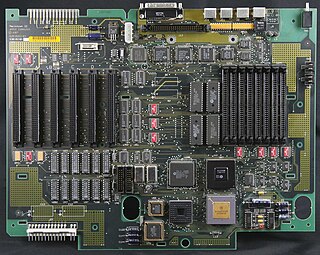
NuBus is a 32-bit parallel computer bus, originally developed at MIT and standardized in 1987 as a part of the NuMachine workstation project. The first complete implementation of the NuBus was done by Western Digital for their NuMachine, and for the Lisp Machines Inc. LMI Lambda. The NuBus was later incorporated in Lisp products by Texas Instruments (Explorer), and used as the main expansion bus by Apple Computer and a variant called NeXTBus was developed by NeXT. It is no longer widely used outside the embedded market.

VMEbus is a computer bus standard physically based on Eurocard sizes.

The S-100 bus or Altair bus, IEEE 696-1983(withdrawn), is an early computer bus designed in 1974 as a part of the Altair 8800. The S-100 bus was the first industry standard expansion bus for the microcomputer industry. S-100 computers, consisting of processor and peripheral cards, were produced by a number of manufacturers. The S-100 bus formed the basis for homebrew computers whose builders implemented drivers for CP/M and MP/M. These S-100 microcomputers ran the gamut from hobbyist toy to small business workstation and were common in early home computers until the advent of the IBM PC.
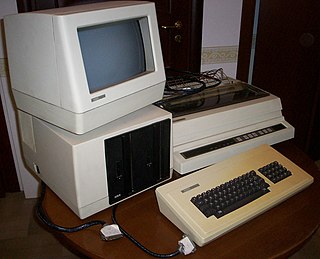
The Xerox 820 Information Processor is an 8-bit desktop computer sold by Xerox in the early 1980s. The computer runs under the CP/M operating system and uses floppy disk drives for mass storage. The microprocessor board is a licensed variant of the Big Board computer.
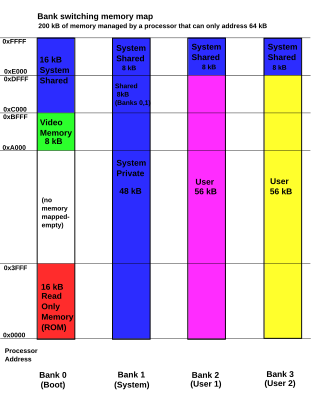
Bank switching is a technique used in computer design to increase the amount of usable memory beyond the amount directly addressable by the processor instructions. It can be used to configure a system differently at different times; for example, a ROM required to start a system from diskette could be switched out when no longer needed. In video game systems, bank switching allowed larger games to be developed for play on existing consoles.

The Z8000 is a 16-bit microprocessor introduced by Zilog in early 1979. The architecture was designed by Bernard Peuto while the logic and physical implementation was done by Masatoshi Shima, assisted by a small group of people. In contrast to most designs of the era, the Z8000 did not use microcode which allowed it to be implemented in only 17,500 transistors.

Multibus is a computer bus standard used in industrial systems. It was developed by Intel Corporation and was adopted as the IEEE 796 bus.
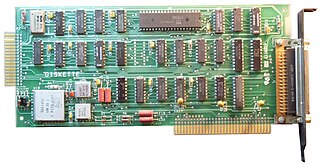
A floppy-disk controller (FDC) has evolved from a discrete set of components on one or more circuit boards to a special-purpose integrated circuit or a component thereof. An FDC directs and controls reading from and writing to a computer's floppy disk drive (FDD). The FDC is responsible for reading data presented from the host computer and converting it to the drive's on-disk format using one of a number of encoding schemes, like FM encoding or MFM encoding, and reading those formats and returning it to its original binary values.

The STEbus is a non-proprietary, processor-independent, computer bus with 8 data lines and 20 address lines. It was popular for industrial control systems in the late 1980s and early 1990s before the ubiquitous IBM PC dominated this market. STE stands for STandard Eurocard.

The Research Machines 380Z was an early 8-bit microcomputer produced by Research Machines in Oxford, England, from 1977 to 1985.

A single-board microcontroller is a microcontroller built onto a single printed circuit board. This board provides all of the circuitry necessary for a useful control task: a microprocessor, I/O circuits, a clock generator, RAM, stored program memory and any necessary support ICs. The intention is that the board is immediately useful to an application developer, without requiring them to spend time and effort to develop controller hardware.
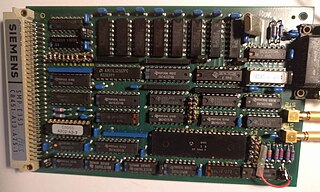
The Europe Card Bus is a computer bus developed in 1977 by the company Kontron, mainly for the 8-bit Zilog Z80, Intel 8080 and Intel 8085 microprocessor families.




















